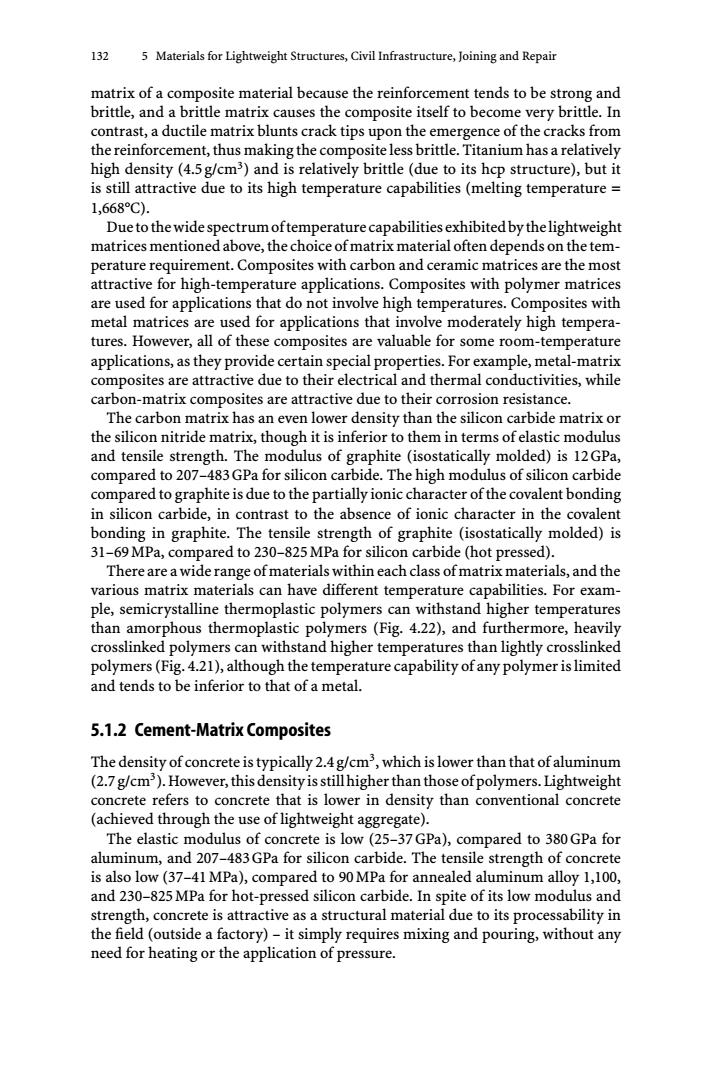正在加载图片...

132 5 Materials for Lightweight Structures,Civil Infrastructure,Joining and Repair matrix of a composite material because the reinforcement tends to be strong and brittle,and a brittle matrix causes the composite itself to become very brittle.In contrast,a ductile matrix blunts crack tips upon the emergence of the cracks from the reinforcement,thus making the composite less brittle.Titanium has a relatively high density(4.5g/cm3)and is relatively brittle (due to its hcp structure),but it is still attractive due to its high temperature capabilities(melting temperature 1,668C). Due to the wide spectrum oftemperature capabilities exhibited by the lightweight matrices mentioned above,the choice of matrix material often depends on the tem- perature requirement.Composites with carbon and ceramic matrices are the most attractive for high-temperature applications.Composites with polymer matrices are used for applications that do not involve high temperatures.Composites with metal matrices are used for applications that involve moderately high tempera- tures.However,all of these composites are valuable for some room-temperature applications,as they provide certain special properties.For example,metal-matrix composites are attractive due to their electrical and thermal conductivities,while carbon-matrix composites are attractive due to their corrosion resistance. The carbon matrix has an even lower density than the silicon carbide matrix or the silicon nitride matrix,though it is inferior to them in terms of elastic modulus and tensile strength.The modulus of graphite (isostatically molded)is 12 GPa, compared to 207-483 GPa for silicon carbide.The high modulus of silicon carbide compared to graphite is due to the partially ionic character of the covalent bonding in silicon carbide,in contrast to the absence of ionic character in the covalent bonding in graphite.The tensile strength of graphite(isostatically molded)is 31-69 MPa,compared to 230-825 MPa for silicon carbide(hot pressed). There are a wide range of materials within each class of matrix materials,and the various matrix materials can have different temperature capabilities.For exam- ple,semicrystalline thermoplastic polymers can withstand higher temperatures than amorphous thermoplastic polymers (Fig.4.22),and furthermore,heavily crosslinked polymers can withstand higher temperatures than lightly crosslinked polymers(Fig.4.21),although the temperature capability of any polymer is limited and tends to be inferior to that of a metal. 5.1.2 Cement-Matrix Composites The density of concrete is typically 2.4 g/cm3,which is lower than that of aluminum (2.7 g/cm).However,this density is still higher than those ofpolymers.Lightweight concrete refers to concrete that is lower in density than conventional concrete (achieved through the use of lightweight aggregate). The elastic modulus of concrete is low(25-37 GPa),compared to 380 GPa for aluminum,and 207-483GPa for silicon carbide.The tensile strength of concrete is also low(37-41 MPa),compared to 90 MPa for annealed aluminum alloy 1,100, and 230-825 MPa for hot-pressed silicon carbide.In spite of its low modulus and strength,concrete is attractive as a structural material due to its processability in the field(outside a factory)-it simply requires mixing and pouring,without any need for heating or the application of pressure.132 5 Materials for Lightweight Structures, Civil Infrastructure, Joining and Repair matrix of a composite material because the reinforcement tends to be strong and brittle, and a brittle matrix causes the composite itself to become very brittle. In contrast, a ductile matrix blunts crack tips upon the emergence of the cracks from the reinforcement, thus making the composite less brittle. Titanium has a relatively high density (4.5g/cm3) and is relatively brittle (due to its hcp structure), but it is still attractive due to its high temperature capabilities (melting temperature = 1,668°C). Duetothewidespectrumoftemperaturecapabilitiesexhibitedbythelightweight matrices mentioned above, the choice of matrix material often depends on the temperature requirement. Composites with carbon and ceramic matrices are the most attractive for high-temperature applications. Composites with polymer matrices are used for applications that do not involve high temperatures. Composites with metal matrices are used for applications that involve moderately high temperatures. However, all of these composites are valuable for some room-temperature applications, as they provide certain special properties. For example, metal-matrix composites are attractive due to their electrical and thermal conductivities, while carbon-matrix composites are attractive due to their corrosion resistance. The carbon matrix has an even lower density than the silicon carbide matrix or the silicon nitride matrix, though it is inferior to them in terms of elastic modulus and tensile strength. The modulus of graphite (isostatically molded) is 12GPa, compared to 207–483GPa for silicon carbide. The high modulus of silicon carbide compared to graphite is due to the partially ionic character of the covalent bonding in silicon carbide, in contrast to the absence of ionic character in the covalent bonding in graphite. The tensile strength of graphite (isostatically molded) is 31–69MPa, compared to 230–825MPa for silicon carbide (hot pressed). There are a wide range of materials within each class of matrix materials, and the various matrix materials can have different temperature capabilities. For example, semicrystalline thermoplastic polymers can withstand higher temperatures than amorphous thermoplastic polymers (Fig. 4.22), and furthermore, heavily crosslinked polymers can withstand higher temperatures than lightly crosslinked polymers (Fig. 4.21), although the temperature capability of any polymer is limited and tends to be inferior to that of a metal. 5.1.2 Cement-Matrix Composites The density of concrete is typically 2.4g/cm3, which is lower than that of aluminum (2.7g/cm3).However,thisdensityisstillhigherthanthoseofpolymers.Lightweight concrete refers to concrete that is lower in density than conventional concrete (achieved through the use of lightweight aggregate). The elastic modulus of concrete is low (25–37GPa), compared to 380GPa for aluminum, and 207–483GPa for silicon carbide. The tensile strength of concrete is also low (37–41MPa), compared to 90MPa for annealed aluminum alloy 1,100, and 230–825MPa for hot-pressed silicon carbide. In spite of its low modulus and strength, concrete is attractive as a structural material due to its processability in the field (outside a factory) – it simply requires mixing and pouring, without any need for heating or the application of pressure